Mapping Potential Zones for Ecotourism Ecosystem Services as a Tool to Promote Landscape Resilience and Development in a Brazilian Municipality
Abstract
1. Introduction
2. Materials and Methods
2.1. Study Area: Brotas, São Paulo State, Brazil
2.2. Methodological Framework
2.2.1. Step 1: Data Acquisition
2.2.2. Step 2: Mapping Parameters and Cartographic Treatment
2.2.3. Step 3: Weight Assignment and Fuzzy Normalization of Parameters
2.2.4. Step 4: Overlapping of Cartographic Parameters
2.2.5. Step 5: Ecotourism Ecosystem Services Potential Zones and Supporting Decision Making
3. Results
3.1. Z1—Low Potential for Ecotourism Ecosystem Services
3.2. Z2—Moderate Potential to Ecotourism Ecosystem Services
3.3. Z3—High Potential for Ecotourism Ecosystem Services
3.4. Z4—Very High potential for Ecotourism Ecosystem Services
4. Discussion
5. Conclusions
Author Contributions
Funding
Conflicts of Interest
References
- Ab’saber, A. Os Domínios de Natureza no Brasil; Ateliê Editorial: São Paulo, Brazil, 2012. [Google Scholar]
- MEA, M.E.A. Ecosystems and Human Well-Being; World Health Organization: Geneva, Switzerland, 2005; Volume 1. [Google Scholar]
- Costanza, R.; de Groot, R.; Sutton, P.; van der Ploeg, S.; Anderson, S.J.; Kubiszewski, I.; Farber, S.; Turner, R.K. Changes in the global value of ecosystem services. Glob. Environ. Chang. 2014, 26, 152–158. [Google Scholar] [CrossRef]
- Costanza, R.; Arge, R.; de Groot, R.; Farberk, S.; Grasso, M.; Hannon, B.; Limburg, K.; Naeem, S.; O’Neill, R.V.; Paruelo, J.; et al. The value of the world’ s ecosystem services and natural capital. Nature 1997, 387, 253–260. [Google Scholar] [CrossRef]
- Englund, O.; Berndes, G.; Cederberg, C. How to analyse ecosystem services in landscapes—A systematic review. Ecol. Indic. 2017, 73, 492–504. [Google Scholar] [CrossRef]
- Parron, L.M.; Fidalgo, E.C.C.; Luz, A.P.; Campanha, M.M.; Turetta, A.P.D.; Pedreira, B.C.C.G.; Prado, R.B. Research on ecosystem services in Brazil: A systematic review. Rev. Ambient. Agua 2019, 14, 445–458. [Google Scholar] [CrossRef]
- Hasan, S.S.; Zhen, L.; Miah, M.G.; Ahamed, T.; Samie, A. Impact of Land Use Change on Ecosystem Services: A Review; Elsevier: Amsterdam, The Netherlands, 2020; ISBN 8801920156. [Google Scholar]
- Baveye, P.C.; Baveye, J.; Gowdy, J. Soil “ecosystem” services and natural capital: Critical appraisal of research on uncertain ground. Front. Environ. Sci. 2016, 4, 1–49. [Google Scholar] [CrossRef]
- Butchart, S.H.M.; Collen, B.; Van Strien, A.; Nat, C.; Bruno, J.; Chanson, J.; Galloway, J.N.; Genovesi, P. Global Biodiversity: Indicators of Recent Declines. Science 2010, 328, 1164–1168. [Google Scholar] [CrossRef]
- de Oliveira, T.E.; de Freitas, D.S.; Gianezini, M.; Ruviaro, C.F.; Zago, D.; Mércio, T.Z.; Dias, E.A.; do Nascimento Lampert, V.; Barcellos, J.O.J. Agricultural land use change in the Brazilian Pampa Biome: The reduction of natural grasslands. Land Use Policy 2017, 63, 394–400. [Google Scholar] [CrossRef]
- Garrett, R.D.; Koh, I.; Lambin, E.F.; le Polain de Waroux, Y.; Kastens, J.H.; Brown, J.C. Intensification in agriculture-forest frontiers: Land use responses to development and conservation policies in Brazil. Glob. Environ. Chang. 2018, 53, 233–243. [Google Scholar] [CrossRef]
- Schielein, J.; Börner, J. Recent transformations of land-use and land-cover dynamics across different deforestation frontiers in the Brazilian Amazon. Land Use Policy 2018, 76, 81–94. [Google Scholar] [CrossRef]
- Marchese, D.; Reynolds, E.; Bates, M.E.; Morgan, H.; Clark, S.S.; Linkov, I. Resilience and sustainability: Similarities and differences in environmental management applications. Sci. Total Environ. 2018, 613–614, 1275–1283. [Google Scholar] [CrossRef]
- Walker, B.; Hooling, C.S.; Carpenter, S.; Kinzig, A. Resilience, Adaptability and Transformability in Social-Ecological Systems. Ecol. Soc. 2004, 9. [Google Scholar] [CrossRef]
- Cumming, G.S.; Olsson, P.; Holling, C.S. Resilience, experimentation, and scale mismatches in social-ecological landscapes. Landsc. Ecol. 2013, 1139–1150. [Google Scholar] [CrossRef]
- Baral, N. Evaluation and resilience of ecotourism in the Annapurna Conservation Area, Nepal. Environ. Conserv. 2014, 41, 84–92. [Google Scholar] [CrossRef]
- Choi, Y.E.; Song, K.; Kim, M.; Lee, J. Transformation planning for resilientwildlife habitats in ecotourism systems. Sustainability 2017, 9, 487. [Google Scholar] [CrossRef]
- Sgroi, F. Forest resources and sustainable tourism, a combination for the resilience of the landscape and development of mountain areas. Sci. Total Environ. 2020, 736, 139539. [Google Scholar] [CrossRef] [PubMed]
- Fonseca, J.M.A.A.; de Melo, S.M.C.; de Carvalho, W.G. O Ecoturismo como alternativa sustentável para gestão da RPPN Catedral do Jalapão (TO). Rev. Bras. Ecotur. 2018, 11, 9–31. [Google Scholar] [CrossRef]
- Mondino, E.; Beery, T. Ecotourism as a learning tool for sustainable development. The case of Monviso Transboundary Biosphere Reserve, Italy. J. Ecotourism 2019, 18, 107–121. [Google Scholar] [CrossRef]
- Salemi, M.; Jozi, S.A.; Malmasi, S.; Rezaian, S. Conceptual framework for evaluation of ecotourism carrying capacity for sustainable development of Karkheh protected area, Iran. Int. J. Sustain. Dev. World Ecol. 2019, 26, 354–366. [Google Scholar] [CrossRef]
- Brazilian Government. Ecoturismo: Orientações Básicas; Ministério doTurismo: Brasília, Brazil, 2010; ISBN 9788575223857.
- de Groot, R.S.; Alkemade, R.; Braat, L.; Hein, L.; Willemen, L. Challenges in integrating the concept of ecosystem services and values in landscape planning, management and decision making. Ecol. Complex. 2010, 7, 260–272. [Google Scholar] [CrossRef]
- Çetinkaya, C.; Kabak, M.; Erbas, M.; Özceylan, E. Evaluation of ecotourism sites: A GIS-based multi-criteria decision analysis. Kybernetes 2018. [Google Scholar] [CrossRef]
- Aliani, H.; BabaieKafaky, S.; Saffari, A.; Monavari, S.M. Land evaluation for ecotourism development—An integrated approach based on FUZZY, WLC, and ANP methods. Int. J. Environ. Sci. Technol. 2017, 14. [Google Scholar] [CrossRef]
- Kertész, Á.; Nagy, L.A.; Balázs, B. Land Use Policy Effect of land use change on ecosystem services in Lake Balaton Catchment. Land Use Policy 2019, 80, 430–438. [Google Scholar] [CrossRef]
- Paramati, S.R.; Alam, S.; Chen, C. The Effects of Tourism on Economic Growth and CO2 Emissions: A Comparison between Developed and Developing Economies. J. Travel Res. 2016. [Google Scholar] [CrossRef]
- Paudyal, K.; Baral, H.; Bhandari, S.P.; Bhandari, A.; Keenan, R.J. Spatial assessment of the impact of land use and land cover change on supply of ecosystem services in Phewa watershed, Nepal. Ecosyst. Serv. 2019, 36, 100895. [Google Scholar] [CrossRef]
- Gigović, L.; Pamučar, D.; Lukić, D.; Marković, S. GIS-Fuzzy DEMATEL MCDA model for the evaluation of the sites for ecotourism development: A case study of “Dunavski ključ” region, Serbia. Land Use Policy 2016, 58, 348–365. [Google Scholar] [CrossRef]
- Jeong, J.S.; García-Moruno, L.; Hernández-Blanco, J.; Jaraíz-Cabanillas, F.J. An operational method to supporting siting decisions for sustainable rural second home planning in ecotourism sites. Land Use Policy 2014, 41, 550–560. [Google Scholar] [CrossRef]
- Bunruamkaew, K.; Murayama, Y. Site Suitability Evaluation for Ecotourism Using GIS & AHP: A Case Study of Surat Thani Province, Thailand. Procedia Soc. Behav. Sci. 2011, 21, 269–278. [Google Scholar] [CrossRef]
- Sturiale, L.; Scuderi, A.; Timpanaro, G.; Matarazzo, B. Sustainable use and conservation of the environmental resources of the etna park (unesco heritage): Evaluation model supporting sustainable local development strategies. Sustainability 2020, 12, 1453. [Google Scholar] [CrossRef]
- Sahani, N. Assessment of ecotourism potentiality in GHNPCA, Himachal Pradesh, India, using remote sensing, GIS. Asia-Pac. J. Reg. Sci. 2019, 3. [Google Scholar] [CrossRef]
- Nahuelhual, L.; Carmona, A.; Lozada, P.; Jaramillo, A.; Aguayo, M. Mapping recreation and ecotourism as a cultural ecosystem service: An application at the local level in Southern Chile. Appl. Geogr. 2013, 40, 71–82. [Google Scholar] [CrossRef]
- Thompson, B.S.; Friess, D.A. Stakeholder preferences for payments for ecosystem services (PES) versus other environmental management approaches for mangrove forests. J. Environ. Manag. 2019, 233, 636–648. [Google Scholar] [CrossRef]
- Bocco, G.; Mendoza, M.; Velazquez, A. Remote sensing and GIS-based regional geomorphological mapping—A tool for land use planning in developing countries. Geomorphology 2001, 39, 211–219. [Google Scholar] [CrossRef]
- Kosmus, M.; Renner, I.; Ullrich, S. Integração de Serviços Ecossistêmicos ao Planejamento do Desenvolvimento. 2012. Available online: http://www.aboutvalues.net/es/data/six_steps/integr_ecosys_serv_in_dev_planning_pt.pdf (accessed on 5 May 2020).
- de Cruz, R.C.A. Políticas públicas de turismo no Brasil: Território usado, território negligenciado. Geosul 2005, 20, 27–43. [Google Scholar]
- RepórterBrasil Por Trás do Alimento: Você Bebe Agrotóxicos? Available online: https://portrasdoalimento.info/agrotoxico-na-agua/ (accessed on 5 May 2020).
- de Moraes, C.C.M.; Santana, M.S.; Simões, P.M.L.; da Conceição, R.A.C.; da Silva, S.F. Carta de Suscetibilidade a Movimentos Gravitacionais de Massa e Inundação: Município de Brotas, SP; CPRM: Brasília, Brazil, 2020. [Google Scholar]
- Mezzalira, S. Lexico Estratigrãfico do Estado de Sao Paulo; Geological Institute: São Paulo, Brazil, 1981. [Google Scholar]
- Guerrero, J.V.R.; Moschini, L.E.; De Lollo, J.A.; de Melo, N.A.T. Mapeamento da Aptidão ao Ecoturismo Como Instrumento de Planejamento Territorial Sustentável: Estudo de Caso no Município de Brotas, sp. ACTA Geogr. 2018, 12, 143–155. [Google Scholar]
- Peixoto, C.A.B. Geodiversidade do Estado de São Paulo, 1st ed.; CPRM: São Paulo, Brazil, 2010.
- Brotas Informações Municipais. Available online: https://brotas.sp.gov.br/ (accessed on 22 April 2018).
- de Salis, S.M. Composiçxo Florística e Estrutura de um Remanescente de Mata Ciliar do Rio Jacaré-Pepira, Brotas, sp. 1990. Available online: https://ainfo.cnptia.embrapa.br/digital/bitstream/item/181075/1/Suzana-Salis.pdf (accessed on 5 May 2020).
- EMBRAPA Classificação Climática de Koppen. Available online: https://www.cnpf.embrapa.br/pesquisa/efb/clima.htm (accessed on 22 July 2017).
- Martins, R.C.; Madureira, G.A. Do “buraco” ao atrativo turístico: Uma sociologia da ressignificação do rural. Rev. Econ. Sociol. Rural 2019, 57, 326–338. [Google Scholar] [CrossRef]
- Pereira, M.F.V.; Gonçalves, A.R. O Ecoturismo em Brotas-Sp: Ação Pública e Privada na Produção da Localidade Turística. Geografia 2004, 29, 159–167. [Google Scholar]
- Valeriano, M.D.M. Topodata: Guia Para Utilização De Dados; IINPE: São José dos Campos, Brazil, 2008. [Google Scholar]
- Brazil. Decreto N° 89.817 de 20 de Junho de 1984: Normas Técnicas da Cartografia Nacional; Diario Oficial da União: Brasília, Brazil, 1984. [Google Scholar]
- Malczewski, J.; Rinner, C. Multicriteria Decision Analysis in Geographic Information Science; Springer: New York, NY, USA, 2015. [Google Scholar]
- Brotas, P.M. Inventário Turístico Municipal de Brotas; Brotas Municipal Government: Brotas, Brazil, 2018.
- IAC. Levantamento Pedológico Semi-Detalhado do Estado de São Paulo—Quadrícula de Brotas. SF.22-Z-B-III-4; IAC: Campinas, Brazil, 1981. [Google Scholar]
- Francisca, F.; Rovani, M.; Cassol, R. CARTOGRAFIA TEMÁTICA: Uma contribuição na análise geográfica do município de Barão de Cotegipe/RS THEMATIC MAPPING: A contribution to the geographical analysis of the municipality of Barão de Cotegipe/RS CARTOGRAFÍA TEMÁTICA: Una contribución al an. Ateliê Geogr. 2012, 6, 33–54. [Google Scholar]
- Kainz, W. Fuzzy Logic and GIS, 1st ed.; University of Vienna: Viena, Austria, 2007. [Google Scholar]
- Cereda Junior, A. Análise De Fragilidade Ambiental Com Métodos Multicritério—Críticas E Proposta Metodológica; Universidade Federal de São Carlos: São Carlos, Brazil, 2011. [Google Scholar]
- Zadeh, L.A. Fuzzy Sets. Inf. Control 1965, 8, 338–353. [Google Scholar] [CrossRef]
- Burrough, P.A.; McDonnel, R.A. Principles of Geographical Information Systems; Oxford University Press: New York, NY, USA, 1998. [Google Scholar]
- Ferreira, M.C. Iniciação à Análise Geoespacial: Teoria, Técnicas e Exemplos para Geoprocessamento; Editora Unesp: São Paulo, Brazil, 2014. [Google Scholar]
- Saaty, T.L. The Analytical Hierarchy Process; Mc Graw Hill International: New York, NY, USA, 1980. [Google Scholar]
- Moreira, F.R.; Barbosa, C.; Câmara, G.; Filho, R.A. Inferência Geográfica e suporte à decisão. In Introdução à Ciência da Geoinformação; Câmara, G., Ed.; INPE: São José dos Campos, Brazil, 2001. [Google Scholar]
- Fox, T.; Rohweder, J.; Hlavacek, E.; Dieck, J. Decision Support Systems. Available online: https://www.usgs.gov/centers/umesc/science/decision-support-systems?qt-science_center_objects=0#qt-science_center_objects (accessed on 28 May 2020).
- Cereda, A., Jr.; Röhm, S. Proposal and Analysis of Environmental Fragility Model Using Multicriteria Analysis and Fuzzy Logic for Integrated Landscape Mapping. J. Urban Environ. Eng. 2014, 8, 28–37. [Google Scholar] [CrossRef]
- Silva, K.B.; Mattos, J.B. A spatial approach for the management of groundwater quality in tourist destinations. Tour. Manag. 2020, 79, 104079. [Google Scholar] [CrossRef]
- Fazito, M.; Scott, M.; Russell, P. The dynamics of tourism discourses and policy in Brazil. Ann. Tour. Res. 2016, 57, 1–17. [Google Scholar] [CrossRef]
- MapBiomas Coleção 4 da Série Anual de Mapas de Cobertura e Uso de Solo do Brasil. Available online: https://mapbiomas.org/ (accessed on 22 January 2020).
- De Andrade, N.S.F.; Filho, M.V.M.; Torres, J.L.R.; Pereira, G.T.; Júnior, J.M. Impacto Técnico e Econômico das Perdas de Solo e Nutrientes por Erosão no Cultivo da Cana-de-Açúcar. Eng. Agric. 2011, 31, 539–550. [Google Scholar] [CrossRef]
- Corrêa, E.A.; Moraes, I.C.; Lupinacci, C.M.; de Geomorfologia, R.B. Influência do Cultivo de Cana-de-Açúcar Nas Perdas de Solo por Erosão Hídrica em Cambissolos no Estado de São Paulo. Rev. Bras. Geomorfol. 2018, 19, 150–175. [Google Scholar] [CrossRef]
- Ronquim, C.C. Queimada na Colheita da Cana-de-Açúcar: Impactos Ambientais; Sociais e Econômicos: Campinas, Brazil, 2010. [Google Scholar]
- Guerrero, J.V.R.; De Lollo, J.A.; Lorandi, R. Cartografia Geoambiental Como Base para Planejamento Territorial na Bacia do rio Clarinho, sp. Rev. Bras. Cartogr. 2016, 68, 313–326. [Google Scholar]
- De Lollo, J.A.; Guerrero, J.V.R.; Abe, A.C.P.; Lorandi, R. IAEG/AEG Annual Meeting Proceedings, San Francisco, California; Springer International Publishing: Berlin, Germany, 2019. [Google Scholar]
- Brasil. Law 12.651/2012—Dispõe Sobre a Proteção da Vegetação Nativa; Diário Oficial da União: Brasília, Brazil, 2012. [Google Scholar]
- Schäffer, W.B.; Rosa, M.R.; de Aquino, L.C.S.; de Medeiros, J.D. Áreas de Preservação Permanente e Unidades de Conservação & Áreas de Risco. O que uma Coisa tem a ver Com a Outra? Relatório de Inspeção da Área Atingida Pela Tragédia das Chuvas na Região Serrana do Rio de Janeiro; MMA: Brasília, Brazil, 2011. [Google Scholar]
- Nunes, S.; Gastauer, M.; Cavalcante, R.B.L.; Ramos, S.J.; Caldeira, C.F.; Silva, D.; Rodrigues, R.R.; Salomão, R.; Oliveira, M.; Souza-Filho, P.W.M.; et al. Challenges and opportunities for large-scale reforestation in the Eastern Amazon using native species. For. Ecol. Manag. 2020, 466, 118120. [Google Scholar] [CrossRef]
- Ota, L.; Herbohn, J.; Gregorio, N.; Harrison, S. Reforestation and smallholder livelihoods in the humid tropics. Land Use Policy 2020, 92, 104455. [Google Scholar] [CrossRef]
- Ruprecht, J.; Sparks, T.; Liu, N.; Dell, B.; Harper, R. Using reforestation to reverse salinisation in a large watershed. J. Hydrol. 2019, 577, 123976. [Google Scholar] [CrossRef]
- Machado, R.A.S.; Oliveira, A.G.; Lois-González, R.C. Urban ecological infrastructure: The importance of vegetation cover in the control of floods and landslides in Salvador/Bahia, Brazil. Land Use Policy 2019, 89, 104180. [Google Scholar] [CrossRef]
- Absy, M.L. Avaliação de Impacto Ambiental: Agentes Sociais, Procedimentos e Ferramentas; IBAMA: Brasíia, Brazil, 1995.
- TerritorioSelvagem EcoParque Jacaré. Available online: https://www.territorioselvagem.com.br/atividades/eco-parque-jacare/ (accessed on 5 May 2020).
- de Azevedo, R.M.M.; Lopes, R.M.R.; Gonçalves, S. Resignificação do rural e sua relação com o urbano: O turismo como expressão de novas possibilidades. Rev. Bras. Ecotur. 2013, 6, 824–835. [Google Scholar] [CrossRef]
- Layrargues, P.P. A função social do ecoturismo. Bol. Técnico Senac 2004, 30, 38–45. [Google Scholar] [CrossRef]
- Padilha, A.C.M.; Azevedo, J.B.; Wittmann, M.L.; Docena, L.T.; De Mattos Fagundes, P. Turismo rural e recursos hídricos no município de Carazinho (RS): Um estudo empírico identificando oportunidades e desafios. Rev. Bras. Ecotur. 2015, 8, 74–92. [Google Scholar] [CrossRef]
- Santana, E.L.; Santos, J.C.V. Lago de São Simão e o desenvolvimento do turismo rural: Uma nova atividade econômica sustentada pelo trabalho familiar. Rev. Bras. Ecotur. 2016, 9, 668–683. [Google Scholar] [CrossRef]
- Cunha, A.M. Turismo rural de base comunitária em Santo Antônio da Patrulha (RS). Rev. Bras. Ecotur. 2014, 7, 750–761. [Google Scholar] [CrossRef]
- BrotasOnline Saltos Park. Available online: http://brotasonline.com.br (accessed on 5 May 2020).
- MarinaBroa Broa em Fotos. Available online: http://marinabroa.com.br/conheca-a-represa-do-broa/ (accessed on 5 May 2020).
- Ribeiro, O.C.F.; Amaral, S.C.F. Entre o lazer esportivo participativo e ambiental e o lazer turístico—As políticas públicas de lazer em Brotas/SP. Mov. Rev. Esc. Educ. Física UFRGS 2016, 1, 63–74. [Google Scholar] [CrossRef]
- Budeanu, A.; Miller, G.; Moscardo, G.; Ooi, C.S. Sustainable tourism, progress, challenges and opportunities: An introduction. J. Clean. Prod. 2016, 111, 285–294. [Google Scholar] [CrossRef]
- Rainero, C.; Modarelli, G. The attractive power of rural destinations and a synergistic community cooperative approach: A “tourismability” case. Sustainability 2020, 12, 7233. [Google Scholar] [CrossRef]
- Cheer, J.M.; Lew, A. Understanding tourism resilience: Adapting to social, political, and economic change. In Tourism, Resilience, and Sustainability: Adapting to Social, Political and Economic Change; Cheer, J.M., Lew, A., Eds.; Routledge: Abingdon, UK, 2017. [Google Scholar]
- MMA Zoneamento Ambiental Municipal. Available online: https://www.mma.gov.br/cidades-sustentaveis/planejamento-ambiental-e-territorial-urbano/itemlist/category/62-planejamento-ambiental-urbano.html (accessed on 20 August 2020).
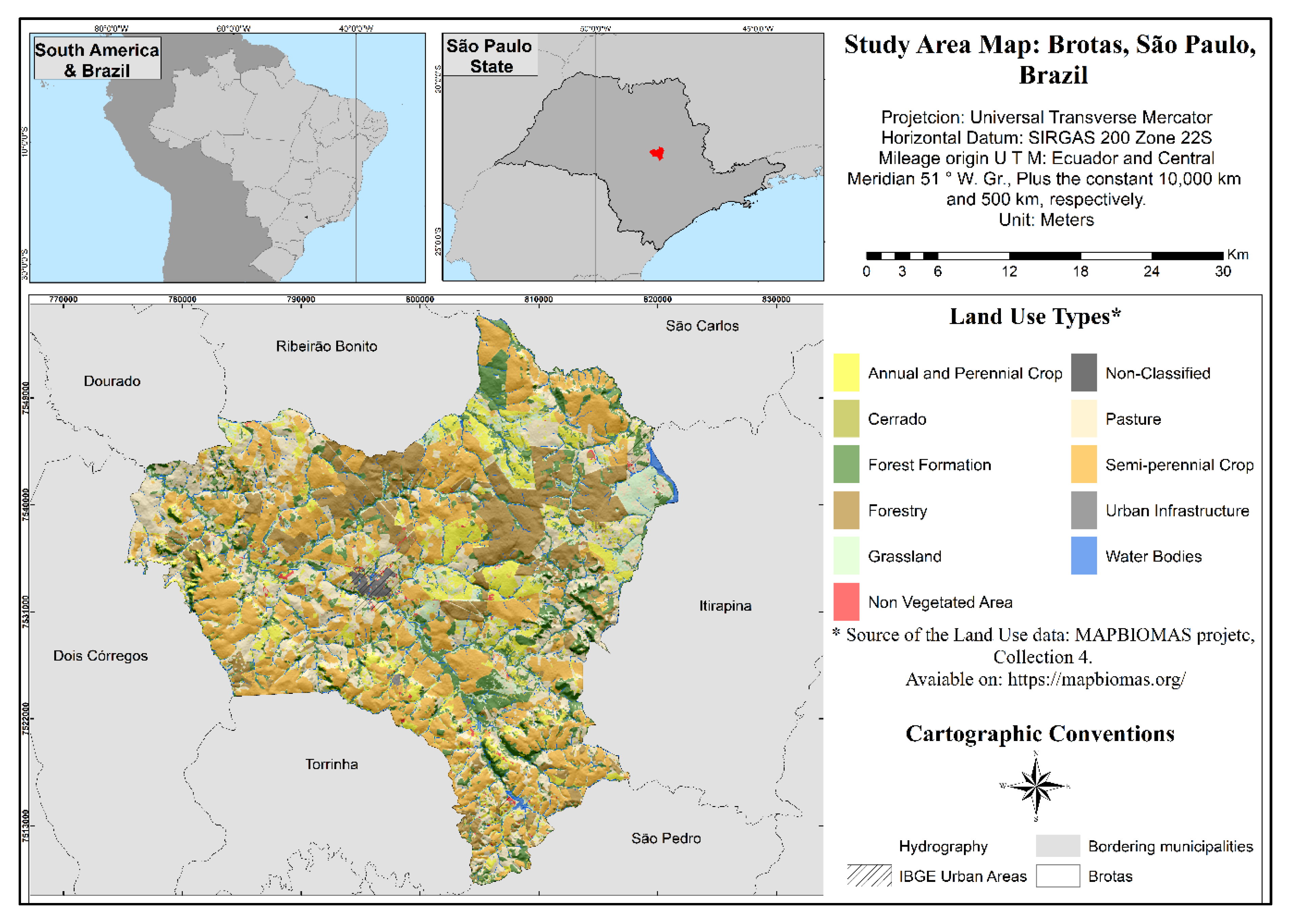
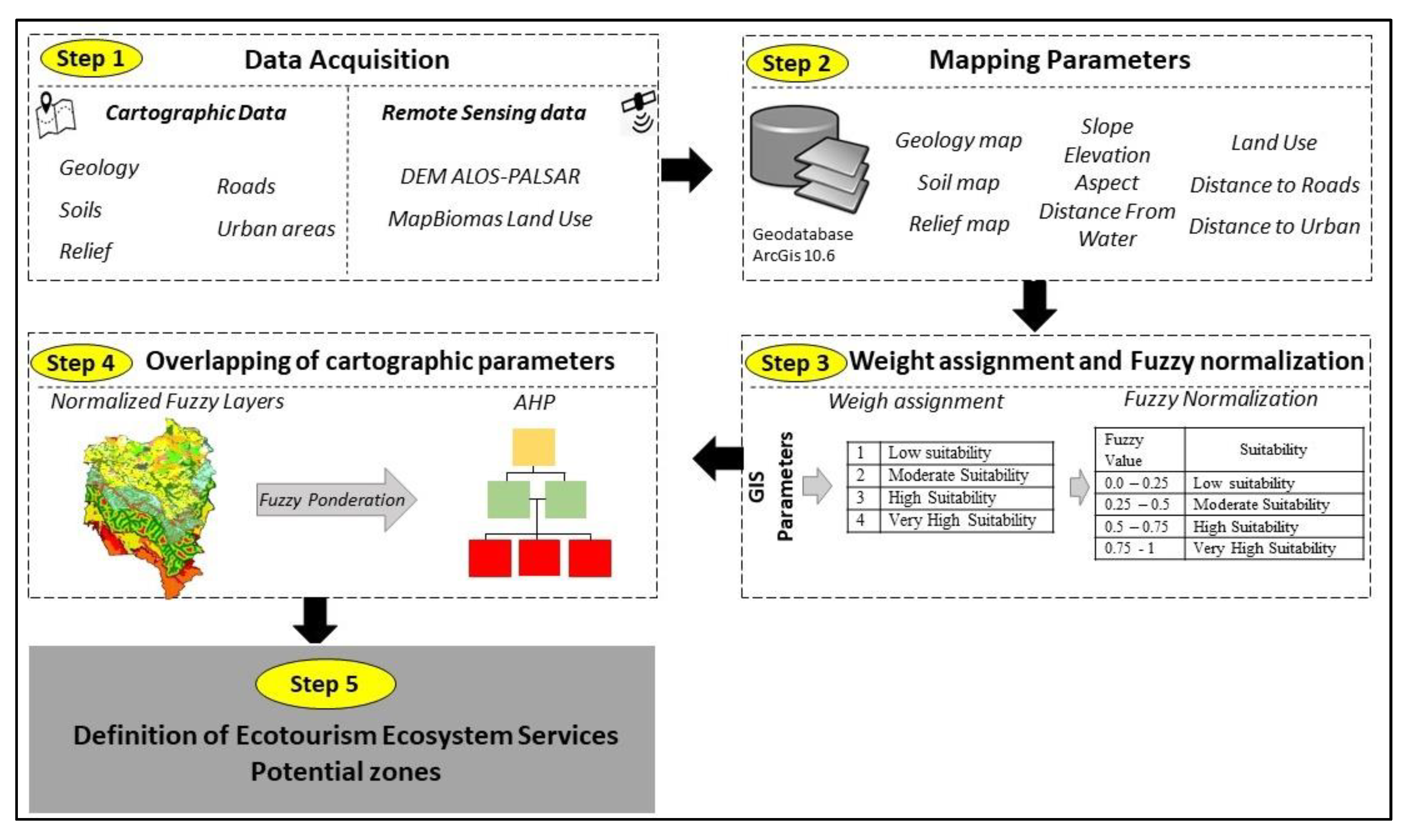
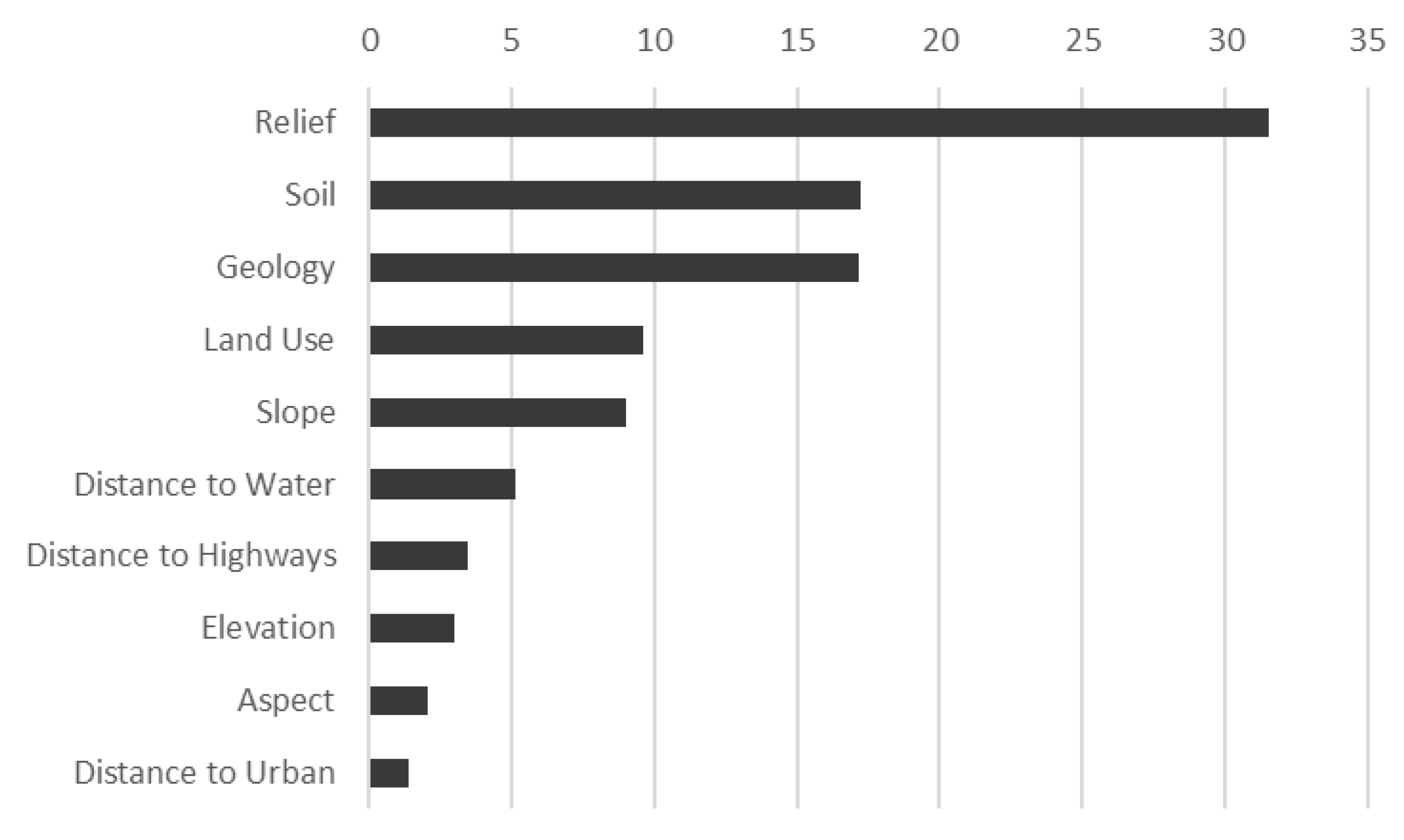
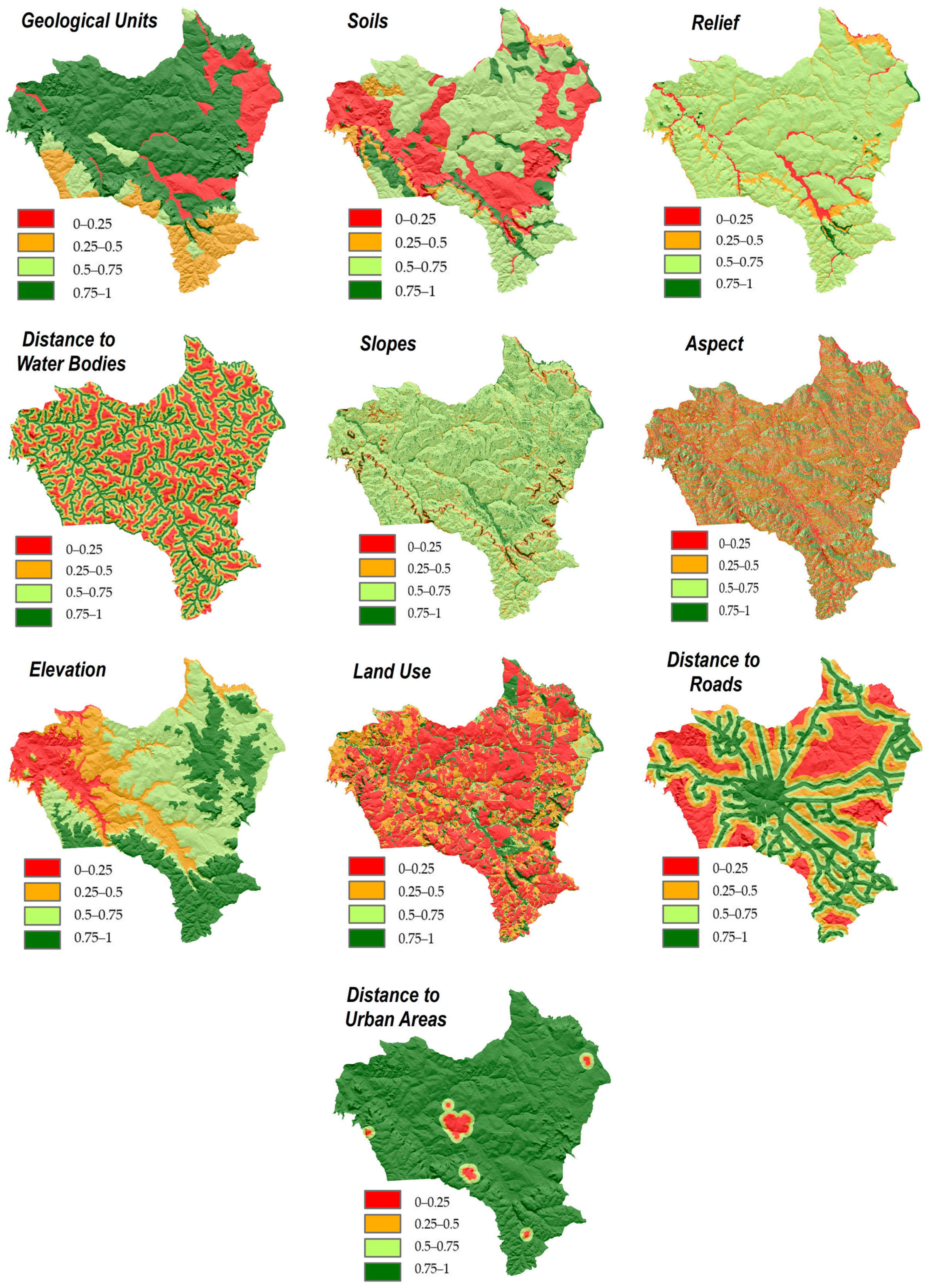
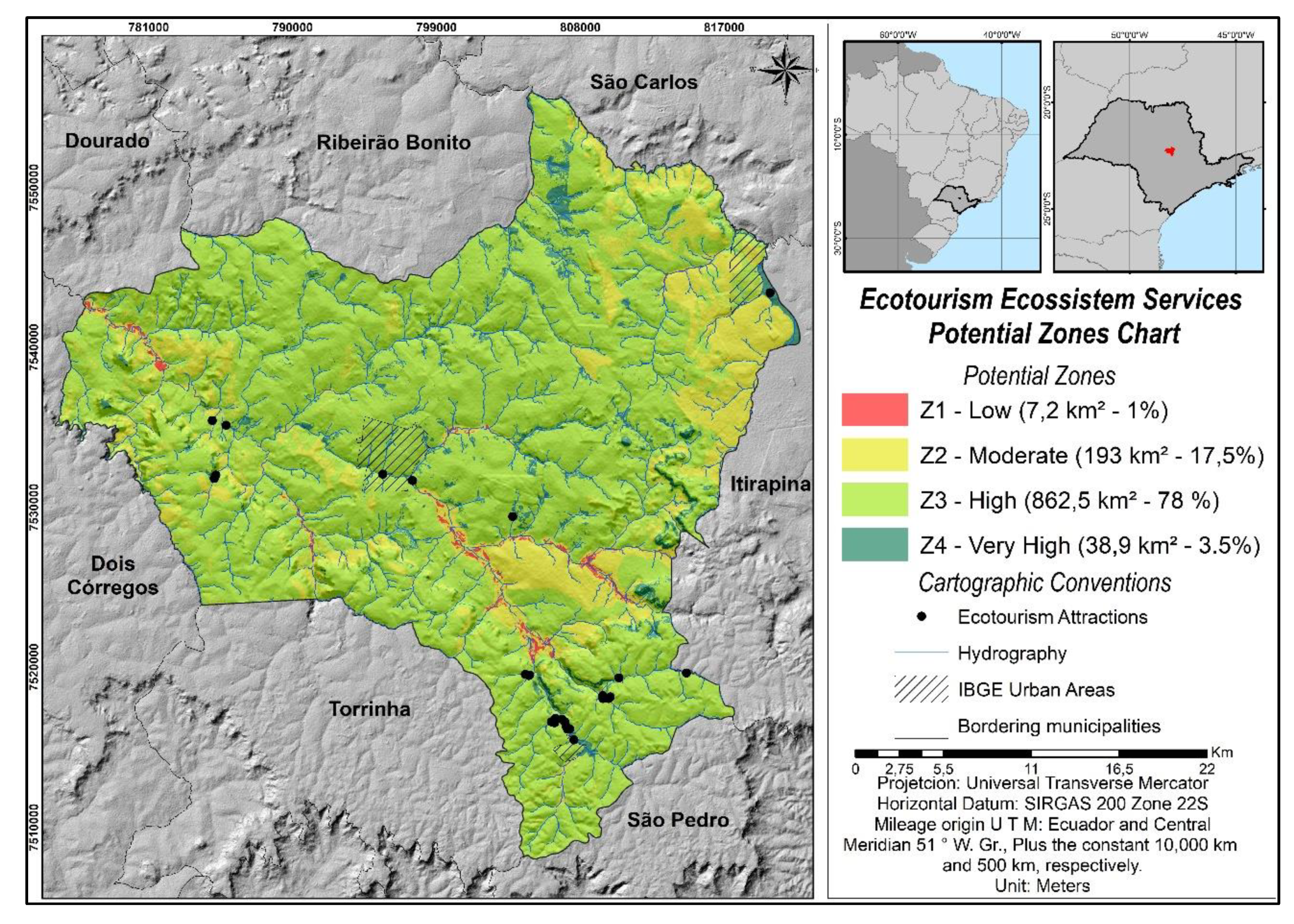
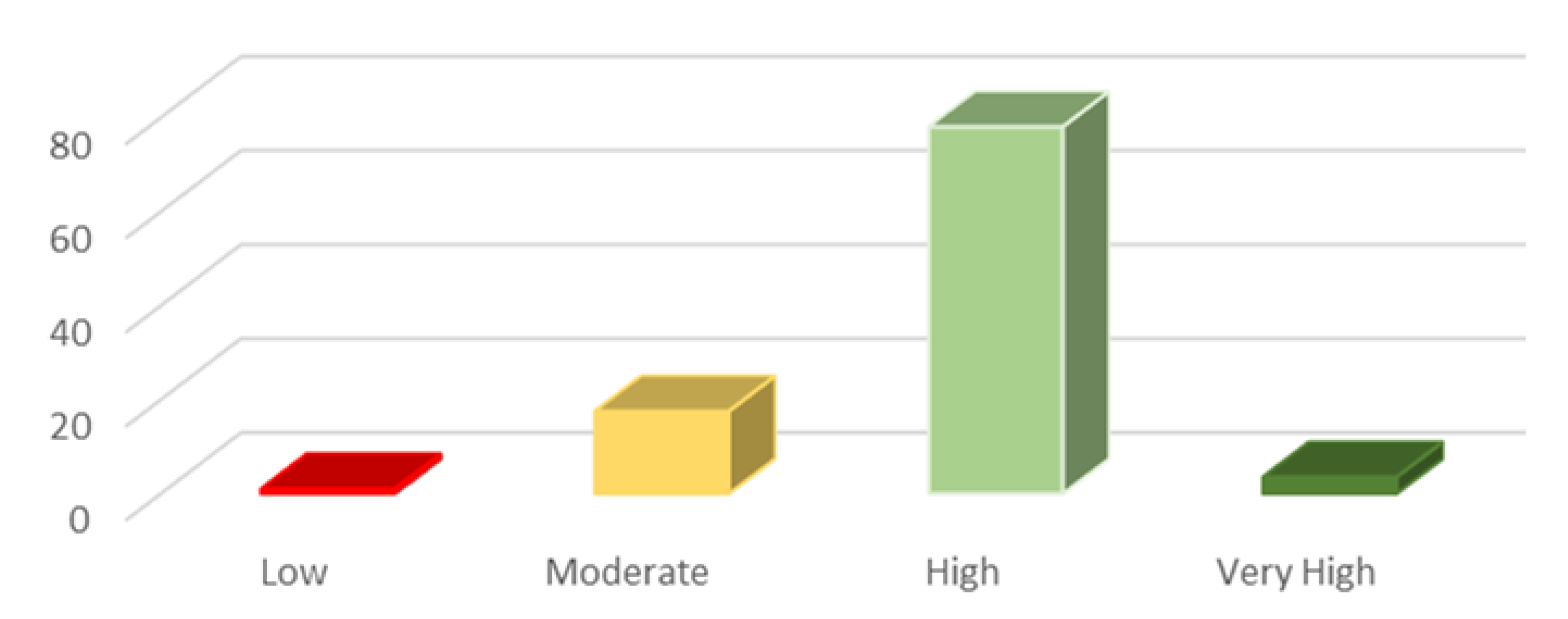

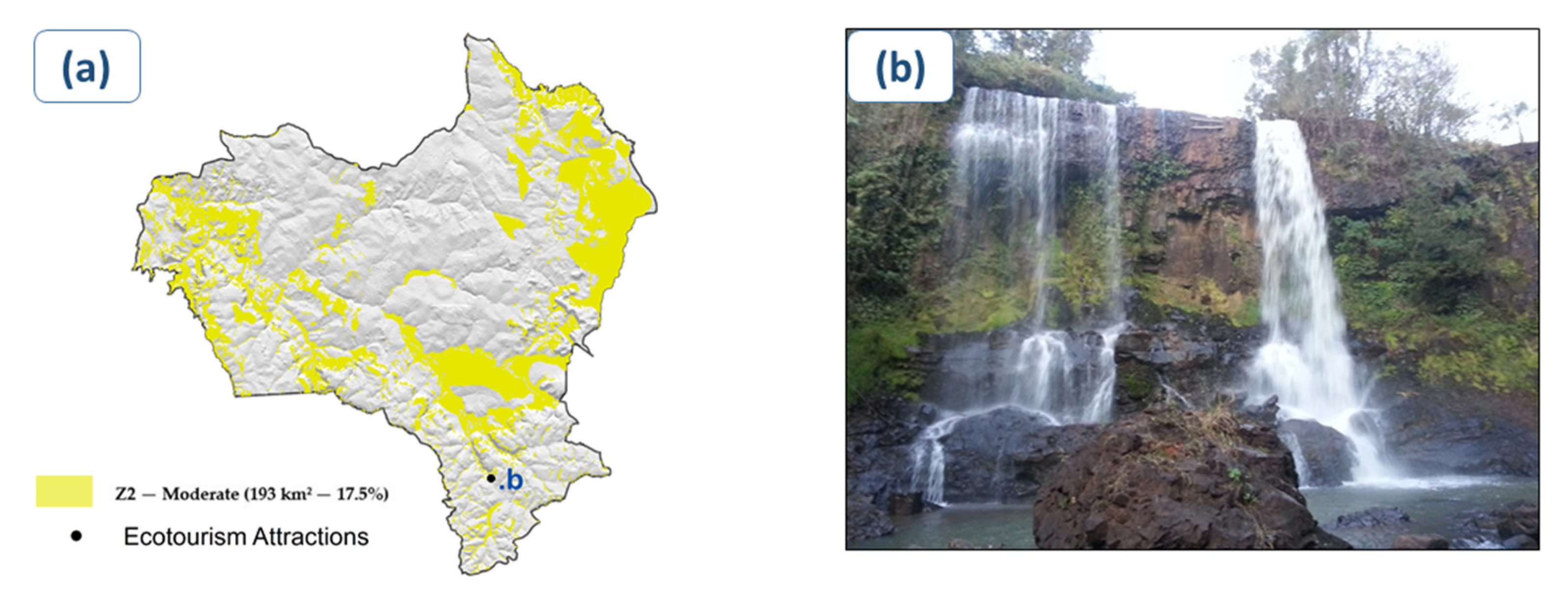
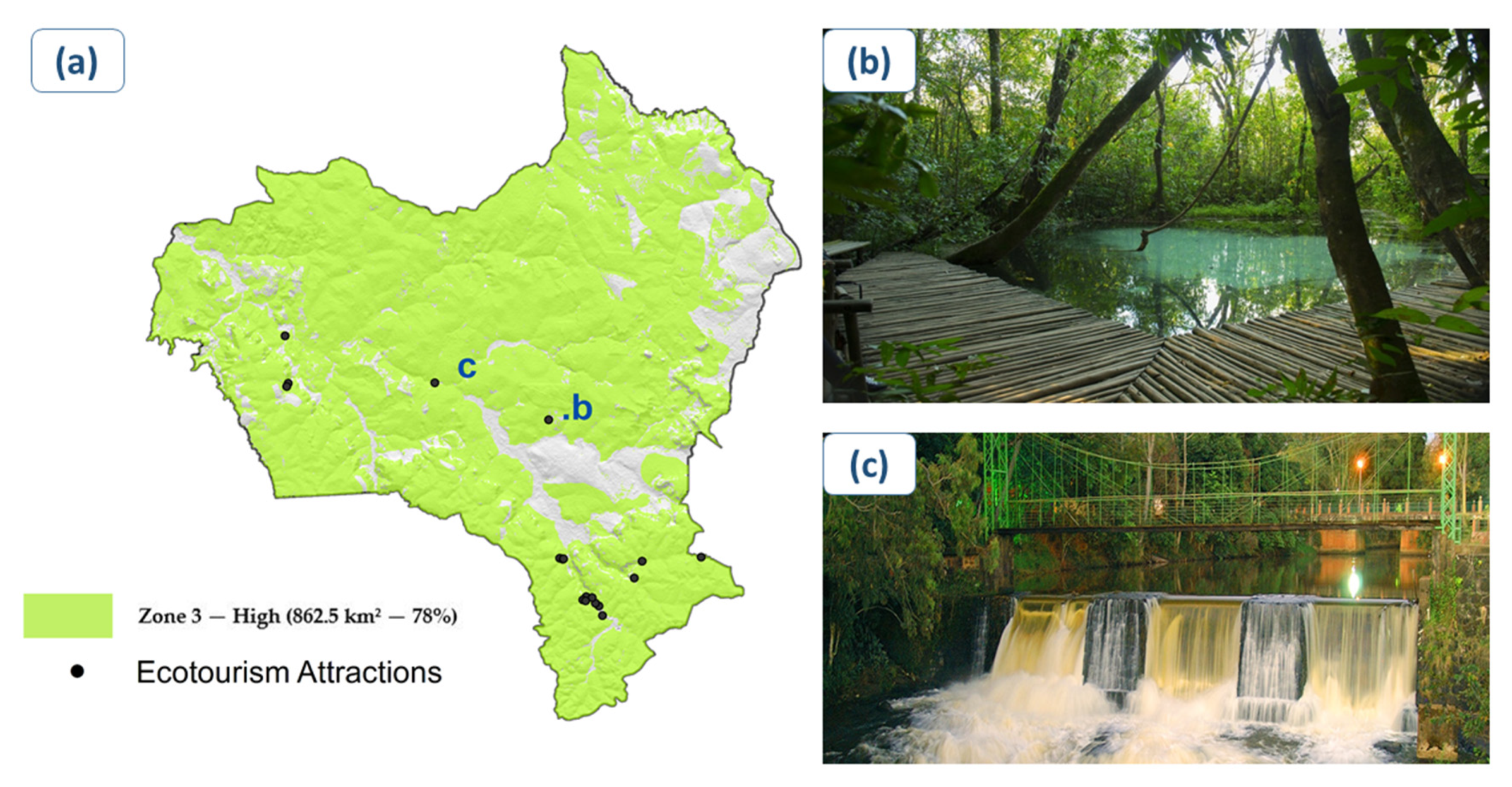

| Group | Data | Source | Year | Scale |
|---|---|---|---|---|
| Geoenvironmental | Geology | IG/SMA | 2014 | 1:75,000 |
| Soils | IAC | 1981 | 1:50,000 | |
| Geodiversity | CPRM | 2015 | Descriptive data | |
| Relief | CPRM | 2020 | 1:100,000 | |
| Topographic | ALOS/PALSAR DEM | JAX | 2011 | 12.5 m pixel |
| Socioeconomic | Urban areas | CPRM | 2020 | 1:50,000 |
| Land Use | MapBiomas | 2018 | 1:50,000 | |
| Roads/Railways | BIT/IM | 2018 | 1:50,000 | |
| Tourist attractions | BROTAS | 2018 | 1:50,000 |
| Group | Parameter | Justification of Weight Assignment | References |
|---|---|---|---|
| Geological Units | The assignment of weights for the geology parameter occurred with the aid of the spatial correlation analysis between ecotourism activities and the characterization of São Paulo State Geodiversity (CPRM). We analyzed the characteristics of rocks, their potential fragility, the landscape complexity and the evolution of the model to identify their favorability to produce ecotourism potential. | [43,44] | |
| Soils | As a superficial attribute, of direct interaction with anthropic activities, we evaluated (from the characteristics of texture, composition, derived rock, and maturity) its vulnerability to the implementation of ecotourism infrastructures. | [53]) | |
| Relief | The area relief directly reflects its geological characteristics and external interactions. Thus, weights were assigned based on the characterization of São Paulo State Geodiversity and on the analysis of how the modeled feature can offer greater propensity to recreational ecosystem services. | [43] | |
| Distance from water bodies | We analyzed whether the water bodies in the study area are essential to ecotourism, since the municipality offers several ecotourism attractions related to rivers, such as rafting, buoy cross, canoeing, etc. | [44] | |
| Slope | As for slopes, we considered that flatter areas are more favorable due to their accessibility. However, the highest slopes were also evaluated as favorable because they produce topographic conditions for the presence of waterfalls and scenic beauty. | authors | |
| Aspect | The Aspect data spatially showed the places with the highest solar incidence in the landscape, directly regulating local microclimates. In the case of the study area, the areas directed to the north are the ones with greater solar insolation thus providing the best conditions for local ecotourism. | [54] | |
| Elevation | We considered that the highest elevations reflect the possibility of scenic beauty and greater visibility to contemplate the local landscape. | [42] | |
| Land Use | Land use reflects the degree of local anthropization. Thus, we considered that the higher the level of landscape naturalness, the greater the propensity to provide ecosystem services related to ecotourism. | authors | |
| Distance from Roads | The distance to the transport routes represents, for this study, the ease of access to ecotourism activities. Thus, the closer to the access roads, the greater the assigned value. We also considered the proximity to the railways, which can be integrated into the ecotourism model. | authors | |
| Distance from negative factors | These are all factors that put ecotourism activity at risk, such as urbanization and highly degraded agricultural areas. Thus, the further away from these areas, the greater the chance that an area will provide ecotourism ES. | authors |
| Parameter | Potential for Ecotourism Ecosystem Services | |||
|---|---|---|---|---|
| Z1 Low | Z2 Moderate | Z3 High | Z4 Very High | |
| Value | 1 | 2 | 3 | 4 |
| Geological Units | Alluvium, Colluvium | Itaqueri | Serra Geral | Botucatu, Pirambóia |
| Soil type | Lithic Entisols, Quartzipsamments Entisols, Entisols | Sandy Ultisols | Red-Yellow Oxisols, Medium/Sandy Ultisols | Red Oxisols, Red Nitisols |
| Relief | Flood Plains, Erosive Edges | Colluvium/Alluvium Ramps, Lithostructural Levels | Hills, Degraded Cliffs, Low Dissected Plateaus | Plateaus, Valleys, Inselbergs, Water Bodies |
| Distance from water bodies | >500 m | 300–500 m | 150–300 m | 0–150 m |
| Land Use | Agriculture, Forestry, Urban, Non-vegetated areas | Pasture | Grassland | Forest, Cerrado, Water |
| Distance from Roads | >1500 m | 750–1500 m | 350–750 m | <350 m |
| Distance from urban | >1000 m | 500–1000 m | 300–500 m | < 300m |
| Aspect | East, West | Southeast, Southwest | Northwest, South | North, Northeast |
| Slope | 25–35% | 15–25% | 3–15% | 0–3%; >35% |
| Elevation | <550 m | 550–650 m | 650–750 m | >750 m |
| Values | Relative Importance Description |
|---|---|
| 1 | Equal importance: Both factors contribute equally to the objective |
| 3 | Moderate importance: One factor is slightly more important than the other |
| 5 | Essential importance. One factor is clearly more important than the other |
| 7 | Demonstrated importance: One factor is strongly favored, and its greatest relevance has been demonstrated in practice |
| 9 | Extreme importance: The evidence that separates the two factors is of the greatest possible order |
| 2,4,6,8 | Intermediate values between judgments: Possibility of additional commitments |
| Relief | Soil | Geology | Land Use | Slope | DW | DR | Elevation | Aspect | DU | |
|---|---|---|---|---|---|---|---|---|---|---|
| Relief | 1 | 3 | 3 | 5 | 5 | 7 | 7 | 7 | 9 | 9 |
| Soil | 0.333 | 1 | 1 | 3 | 3 | 5 | 5 | 7 | 9 | 9 |
| Geology | 0.333 | 0.1 | 1 | 3 | 3 | 5 | 5 | 5 | 7 | 9 |
| Land Use | 0.2 | 0.333 | 0.333 | 1 | 1 | 3 | 5 | 5 | 5 | 7 |
| Slope | 0.2 | 0.333 | 0.333 | 1 | 1 | 3 | 3 | 5 | 5 | 7 |
| DW | 0.143 | 0.2 | 0.2 | 0.333 | 0.333 | 1 | 3 | 3 | 3 | 5 |
| DR | 0.143 | 0.2 | 0.2 | 0.2 | 0.333 | 0.333 | 1 | 1 | 3 | 5 |
| Elevation | 0.143 | 0.143 | 0.2 | 0.2 | 0.2 | 0.333 | 0.1 | 1 | 3 | 3 |
| Aspect | 0.111 | 0.143 | 0.143 | 0.2 | 0.2 | 0.333 | 0.333 | 0.333 | 1 | 3 |
| DU | 0.111 | 0.111 | 0.111 | 0.143 | 0.143 | 0.2 | 0.2 | 0.333 | 0.333 | 1 |
| Zone | Area (km2) | Touristic Attractions | Index Attractions/km2 |
|---|---|---|---|
| 1—Low | 7.2 | 0 | 0 |
| 2—Moderate | 193.058 | 1 | 0.005 |
| 3—High | 862.49 | 18 | 0.02 |
| 4—Very High | 38.8684 | 7 | 0.18 |
Publisher’s Note: MDPI stays neutral with regard to jurisdictional claims in published maps and institutional affiliations. |
© 2020 by the authors. Licensee MDPI, Basel, Switzerland. This article is an open access article distributed under the terms and conditions of the Creative Commons Attribution (CC BY) license (http://creativecommons.org/licenses/by/4.0/).
Share and Cite
Roque Guerrero, J.V.; Teixeira Gomes, A.A.; de Lollo, J.A.; Moschini, L.E. Mapping Potential Zones for Ecotourism Ecosystem Services as a Tool to Promote Landscape Resilience and Development in a Brazilian Municipality. Sustainability 2020, 12, 10345. https://doi.org/10.3390/su122410345
Roque Guerrero JV, Teixeira Gomes AA, de Lollo JA, Moschini LE. Mapping Potential Zones for Ecotourism Ecosystem Services as a Tool to Promote Landscape Resilience and Development in a Brazilian Municipality. Sustainability. 2020; 12(24):10345. https://doi.org/10.3390/su122410345
Chicago/Turabian StyleRoque Guerrero, João Vitor, António Alberto Teixeira Gomes, José Augusto de Lollo, and Luiz Eduardo Moschini. 2020. "Mapping Potential Zones for Ecotourism Ecosystem Services as a Tool to Promote Landscape Resilience and Development in a Brazilian Municipality" Sustainability 12, no. 24: 10345. https://doi.org/10.3390/su122410345
APA StyleRoque Guerrero, J. V., Teixeira Gomes, A. A., de Lollo, J. A., & Moschini, L. E. (2020). Mapping Potential Zones for Ecotourism Ecosystem Services as a Tool to Promote Landscape Resilience and Development in a Brazilian Municipality. Sustainability, 12(24), 10345. https://doi.org/10.3390/su122410345








